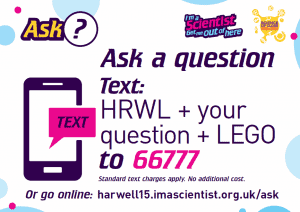 On Saturday July 11th the Harwell Research Campus opened its doors to the public. 10,000 people were expected to come and see some of the most complicated and cutting edge science equipment in the world. Hundreds of volunteers working with that equipment were on hand to speak with the public and show them what happens.
On Saturday July 11th the Harwell Research Campus opened its doors to the public. 10,000 people were expected to come and see some of the most complicated and cutting edge science equipment in the world. Hundreds of volunteers working with that equipment were on hand to speak with the public and show them what happens.
We created a Harwell Zone to allow visitors to text in questions. It was promoted using posters as above.
The logic was that with 10,000 visitors some would not get to ask their questions, or may think of it later, or possibly be too shy to ask in person. It was a family day.
Working with the over-worked (understatement klaxon just sounded) outreach team at Diamond and Harwell we set the zone up and promoted it to exhibitors.
It wasn’t a great success. A mere 14 questions were sent.
However in the interest of continual improvement let’s look at what worked, what didn’t and most importantly what would be do differently if given the chance.
What worked?
The technology did. Visitors were able to text a question, get a response to manage their expectations and a notification when someone answered the question. We also had an enthusiastic response from exhibitors who signed up. However the enthusiasm was far far greater amongst I’m a Scientist alumni. It seems that we didn’t really reach many new scientists. It was in the main scientists we already knew who happened to be already exhibiting.
What didn’t work?
We didn’t reach new scientists. The vast majority of scientists there were not aware that they could have taken part. This meant that the online offering was very patchy. As you wandered around the trained eye (mine) occasionally picked out a poster. The only exception was the RAL Cyrogenics Lab where Vicky Bayliss had printed out extra posters and placed them all around the lab.
We didn’t reach the public. There simply was not enough publicity.
What would we do next time?
- An online Q&A offering needs to be an integral and supplementary part of the open day. Exhibitors should be opting out not in. Taking some questions online should be seen as part of the overall experience. We need to brief potential participants better.
- The online experience needs to match the offline experience. At Harwell some participants were running a desk, others signed up the entire lab. It was disjointed. It would work at the lab level better.
- We should pay more attention to the offline visitor flow. At Harwell many labs had a distinct flow from start to finish. We should have been making sure as people left they not only handed back their lanyards but took away a leaflet offering the chance to ask follow-up questions.
- Use the online zone to supplement the offline experience. At Harwell visitors were invited to view the Diamond Light Synchotron but there were explainers in there. It was a prime spot to publicise the zone.
- Programme notes. People tend to keep the programme notes with them throughout the day and on the way home. That’s the time to mop up any unanswered questions.
- Make more of the online zone. We could take feedback, promote new open days, communicate campaigns, point to more resources. The point is that if someone asks a question online they are in effect asking to engage in conversation. Same as offline. The difference being that online you have the ability to invite the visitor to restart that conversation at any time in the future.

